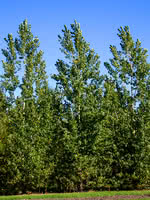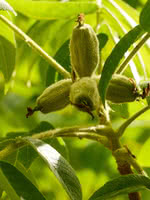Mon-Fri 9am - 5pm Mountain time
Prairie Sky Poplar vs Butternut (White Walnut)
Populus x canadensis Prairie Sky
Juglans cinerea
Prairie Sky Poplar is a fast-growing columnar hybrid poplar developed at Agriculture and Agri-food Canada's Morden Research Station. It is adaptable to many soil conditions and seems to do best in the southern-most parts of the prairies.
Good as a shade or shelterbelt tree, it is often used in buffer zones as a visual screen or hedge. Ideal for lining properties, roads, etc.
Butternut is one of the few walnut varieties native to Canada. The nuts are sought after for their mild, sweet, and oily taste. Ensure this tree is planted in full sun and well-drained soil for best results.
Butternut is self-fertile but it has better yields when planted near other butternuts. It can survive in zone 2, but reliably produces nuts in zone 3.
A top CO2 absorbing species. Experts think this tree may help climate change more than others.

